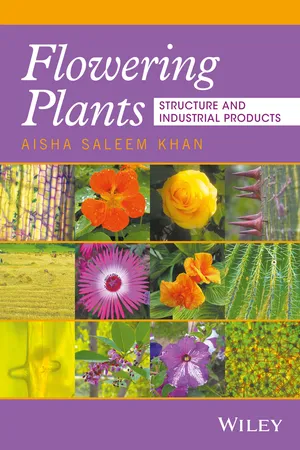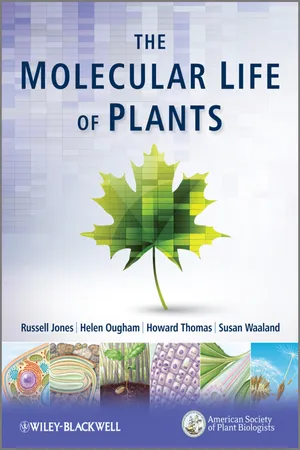Biological Sciences
Angiosperm Life Cycle
The angiosperm life cycle is characterized by alternation of generations, with a dominant sporophyte stage and a reduced gametophyte stage. It involves the production of flowers, which contain the reproductive structures of the plant. The process of double fertilization leads to the formation of seeds within fruits, enabling angiosperms to disperse and reproduce efficiently.
Written by Perlego with AI-assistance
Related key terms
5 Key excerpts on "Angiosperm Life Cycle"
- eBook - ePub
Flowering Plants
Structure and Industrial Products
- Aisha S. Khan(Author)
- 2017(Publication Date)
- Wiley(Publisher)
3 ), auxins, methyl jasmonates, brassinosteroids and other hormones also plays an important role in growth and development of floral organs. Floral initiation is energetically expensive for plants because it requires energy. Furthermore, less availability of important nutrients due to stress conditions may also cause disturbance of hormones required for floral development and this may also effect formation of flowers (Chaudhry & Khan, 2006). If enough sugars are not produced, flower formation will be delayed which also results in delay in fruit formation.5.3 Angiosperms Spend Most Part of Their Lives as Sporophytes and Produce Gametophytes for a Shorter Period of Time
Angiosperms like tall trees spend most part of their lives as sporophytes. Sporophyte (2n) is a spore‐bearing structure which is produced by male (sperms) and female (egg) cells. It is a dominating stage in many angiosperms. A sporophyte gives rise to gametophyte. Many plants (particularly in autumn) which we see all around us are in their sporophytic stage which have not yet started flowering or either produce flowers under certain environmental conditions. Formation of bud represents the beginning of gametophytic stage which leads to floral initiation, pollination, fertilization, seed and fruit formation. Fertilization represents the end of gametophytic stage, and also the beginning of sporophytic stage which through several mitotic divisions forms sporophyte. In angiosperms, meiotic divisions take place only within the anthers and ovaries of flowers. Whole growth and development from seed germination to huge trees is entirely through mitotic divisions.In angiosperms two generations, that is, haploid gametophyte and a diploid sporophyte - eBook - ePub
- Russell L. Jones, Helen Ougham, Howard Thomas, Susan Waaland(Authors)
- 2012(Publication Date)
- Wiley-Blackwell(Publisher)
Part VI RenewalPassage contains an image Chapter 16 Flowering and sexual reproduction
16.1 Introduction to Flowering
Charles Darwin called the sudden appearance and rapid spread of flowering plants during evolution an ‘abominable mystery’. No less mysterious is why the sexual mode of biological reproduction should have arisen in the first place, particularly in plants, where the property of cellular totipotency allows efficient asexual propagation. But sexual reproduction by means of flowers clearly confers fitness benefits and competitive advantages: the first flowering plants emerged 125 million years ago and within the geologically brief timespan of 60 million years angiosperms had established themselves as the dominant form of vegetation, accounting for more than 80% of the species in most ecosystems.As with the principles determining body plan and morphogenesis (see Chapter 12), the reproductive strategies of seed plants and higher animals differ in fundamental aspects (Figure 16.1 ). During early embryogenesis in animals, somatic cells (destined to give rise to all body tissues other than those producing eggs and sperm) are differentiated from germ line cells (committed to becoming the gametes) (Figure 16.1 A). The decision about whether a given cell takes the somatic or germ line route to maturity depends on intrinsic factors, such as cytoplasmic polarity, and on signaling from neighboring cells. Normally, once a cell is committed to the germ line or soma, neither it nor the cells derived from it can divert into the alternative developmental fate. As a consequence, the animal reproductive system is not exposed to the developmental signals that subsequently induce formation of the major somatic tissues and organs, and mutations can be inherited only if they affect germ line cells.Figure 16.1 - eBook - ePub
Science Knowledge for Primary Teachers
Understanding the Science in the QCA Scheme
- Linda Gillard(Author)
- 2013(Publication Date)
- David Fulton Publishers(Publisher)
pollination. Landing on a stigma of another type of flower means that the pollen does not develop further, but if it lands on a ripe stigma of the right type of flower, then it starts to grow. A tube emerges and grows through the style down towards the ovary. To enable this growth, it digests the style tissue, which both makes room for the growth and provides the energy needed. Once in the ovary, it grows towards a weak spot on the surface of the ovule and the nuclei carried in the pollen tube pass into the ovule and fuse with the female nuclei, and this fusion is fertilisation. The ovule is now called the seed and the ovary is called the fruit. These structures continue to develop and eventually the seeds will be dispersed (with or without the fruit) and some will settle where they can successfully germinate and grow into a new plant.Pollination depends on pollen being transferred from a ripe anther to a ripe style. In order for the greatest variation in the next generation, it is better if the pollen from one individual plant is used to pollinate a different plant (cross pollination). However, it is possible that it will be transferred from one flower to another flower on the same plant or even be transferred within the same flower (self pollination). The advantage of sexual reproduction is that it produces variety and, because of the way the sex cells develop, even self pollination gives rise to a new mixing of the parent’s genetic material, and so even self pollination is beneficial.Plant life cyclesA life cycle is a way of showing the developmental stages during the life of an organism. In some organisms, the stages are very distinct and look very different. Two good examples are the frog and the insect.Figure 3.4 Life cyclesWithin this life cycle are the processes of pollination and fertilisation already discussed. Once the seed has developed and been dispersed, it can then germinate to produce the young plant. This seedling begins to feed by photosynthesis, which enables it to grow and mature and so eventually produce flowers and new seeds. The seed contains the embryo plant and dried food reserves provided by the parent plant to enable it to germinate, a sort of packed lunch to last until it can make its own food! The seeds of many plants in our climate are adapted to remain dormant over the winter. Germination - eBook - ePub
- Charles Adams, Mike Early, Jane Brook, Katherine Bamford(Authors)
- 2015(Publication Date)
- Routledge(Publisher)
p. 47 ) to the extent that a high degree of uniformity can be achieved in bedding plants (e.g. for flower colour) and in vegetable seeds (e.g. for size). This chapter focuses largely on sexual reproduction in the angiosperms, the flowering plants, and also explores some of the ways in which flowers, as the organs of sexual reproduction, contribute to reproductive success, in particular as facilitators of pollen transfer.Inflorescences
The inflorescence is the arrangement of flowers on the flower stem. Inflorescences may be made up of a single flower (simple) or many flowers clustered together (compound). In compound inflorescences, each individual flower stalk (pedicel) is attached to a central stalk (rachis or peduncle) and the flowers are gathered together in a block, making a large impact to attract pollinators or providing a landing stage for them to walk over – for example, the capitulum of plants in the Asteraceae family (see p. 57 ). In wind-pollinated flowers, the inflorescence contains many flowers grouped together to maximize release of pollen (e.g. from catkins), as in many trees such as Corylus spp. (hazel) and Betula spp. (birch) or by holding it above the leaves and stems as in grasses (Figure 4.2 ).Figure 4.3 Diagrammatic representations of some inflorescence types. The youngest flowers are indicated by the smallest circlesInflorescences are classified by the order in which flowers open and by the way in which they are arranged on the stem. They can be either cymose, where the stem terminates in a flower so that new flowers originate from the leaf axils further down the stem (e.g. Stellaria media (chickweed)), or racemose, where the apex continues to grow and the youngest flowers are at the top of the stem (e.g. in Digitalis purpurea (foxglove)). Inflorescence types are often characteristic of a particular plant family. Some examples are described below and are illustrated diagrammatically in Figure 4.3 with plant examples shown in Figure 4.4 - eBook - ePub
- T.J. Pandian(Author)
- 2022(Publication Date)
- CRC Press(Publisher)
The advent of gymnosperms marks the transition (i) from ‘aqueous’ fertilization by swimming flagellated spermatozoa in bryophytes and tracheophytes to aerial fertilization by non-motile pollens, and (ii) direct genesis of gametes from naked flowers instead of their production from spores. In them, macro- and micro-spores are generated following meiosis from the respective mother cell. Only one megaspore out of four survive, while all the four microspores are viable, recalling a similar feature in gametogenesis of animals. The surviving megaspore is much larger and retains syncytial organization for long, even up to 3 years. Eventually, it is cellularized and differentiated into two or three archegonia, in each of which a large egg or ovule matures. The microspores, following differentiation into pollens, are dispersed by wind. Within the belatedly developed archegonium, a pollen grain enters through a pollen tube and waits for the maturation of ovule. Eventually, fertilization occurs.In most successful angiosperms, gametogenetic sequences are the same as those of animals. However, the events related to double fertilization complicate the sequences. In spite of being a repetition, it may be wiser to recall these events. In them, the pollen grains and ovules are developed within the distinct compact organ, the flowers. The archeospore or Sperm Mother Cell (SMC) in the developing anther meiotically generate a tetrad of microspores, each of which undergoes to mitosis to produce the pollen cell and germ cell, which, in its turn, undergoes mitosis to produce one germ cell to fuse with the ovule and the other to fuse with the 2n central cell to produce a triploid endosperm (Fig. 10.4 ). In the ovary, the enlarged archeospore differentiates into Mega Mother Cell (MMC), which meiotically generates only one surviving Functional Mega Spore (FMS). In its turn, the FMS undertakes three mitotic divisions to produce eight haploid cells. Of them, two fuses to produce the 2n central cell to fuse with one of the pollen sperm cells and one germ cell fuse with that of pollen to produce a 2n zygote (see also p 15). With these two fusions, fertilization in angiosperms is named as double fertilization. As a result, the ovules develop into seeds and the ovary into fruit.FIGURE 10.4 Gametogenesis and double fertilization in flowering plants.10.3 Gametes and Quantification
Plants generate non-motile and motile gametes in different combinations, which are considered under three major patterns. In the 3,300 speciose Cyanophyceae, only clonal multiplications occur and they do not fall within any pattern (Table 10.2 ). The 6,131 speciose Rhodophyta fall within the pattern IIIa, as they generate non-motile eggs and spermatia. Within pattern I, seven orders of Chlorophyta are included; they also include the less known Xanthophyceae (Salmaso and Tolotti, 2009 ) and Haptophyceae (Eikrem et al., 2017 ), for which values became available with the development of new culturing techniques. In these Chlorophyta, female and male mating types, i.e. the flagellated motile female and male zoospores are produced and released to the exterior. The Phaeophyta (Table 10.2 ) also produce and release female and male zoospores with a pair of unequal flagella borne on the pear-shaped body. Within pattern II, in which the oogamic eggs are retained within a parent body, only the flagellated motile zoospores are released. Unfortunately, no data are available for Pattern II, which may include Chlorophyta like Spirogyra and centric diatoms. However, the value 20,900 species was empirically drawn by subtracting the estimated value of 23,100 species for all other algae (listed Cyanophyceae, Rhodophyta, Chlorophyta and Phaeophyta) from 44,000, the species number, as estimated by Guiry (2012 ). Among algae, 7.5% cyanobionts do not produce gametes; 13.93, 31.07 and 47.50% algae belong to patterns IIIa, I and II, respectively (Table 10.2
Learn about this page
Index pages curate the most relevant extracts from our library of academic textbooks. They’ve been created using an in-house natural language model (NLM), each adding context and meaning to key research topics.




